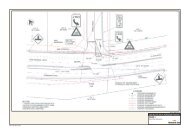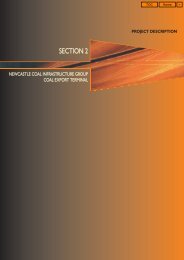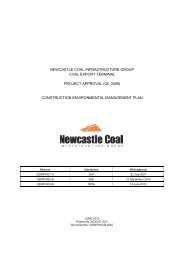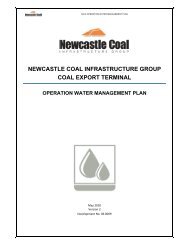Stage 2F Acid Sulphate Soils Management Plan - Newcastle Coal ...
Stage 2F Acid Sulphate Soils Management Plan - Newcastle Coal ...
Stage 2F Acid Sulphate Soils Management Plan - Newcastle Coal ...
- No tags were found...
You also want an ePaper? Increase the reach of your titles
YUMPU automatically turns print PDFs into web optimized ePapers that Google loves.
<strong>Acid</strong> Sulfate Soil <strong>Management</strong> <strong>Plan</strong>various statutory requirements (i.e. licences, permits, Project Approval conditions and relevant laws), the Contractand statutory requirements are to take precedence. In the case of any real or perceived ambiguity betweenelements of this CET ASSMP and the above statutory requirements the Contractor shall first gain clarificationfrom NCIG prior to implementing that element of this CET ASSMP over which the ambiguity is identified.The remainder of this CET ASSMP is structured as follows:Section 2:Section 3:Section 4:Section 5:Provides a definition of ASS and potential environmental effects.Details ASS management measures including sampling, criteria, treatment processes,monitoring and contingency measures.Describes the reporting and review requirements of this CET ASSMP.Lists references cited in this CET ASSMP.2 ACID SULFATE SOILSEstuarine sediments of coastal NSW from the Holocene geological age may contain iron pyrite, the mainconstituent of ASS. These sediments are generally found below 5 metres (m) Australian Height Datum (AHD),typically in coastal and floodplain areas. Pyritic sediments can be divided into classes based on their oxidisedstate. If the pyritic material is being oxidised it will generally have a pH of less than 4.0 and is called actual acidsulfate soil (AASS). If the pyrite material is below the water table and has not been oxidised, it is termed potentialacid sulfate soil (PASS) and generally has a pH of greater than 4.0. The pH has the potential to become muchlower when the PASS is exposed to oxygen. Sediment which, after the addition of hydrogen peroxide, has a pHof less than 2.5 strongly indicates the presence of ASS (Australian Sulfate <strong>Soils</strong> <strong>Management</strong> AdvisoryCommittee [ASSMAC], 1998).Disturbance or poor management and use of ASS can generate sulfuric acid and salts. ASS can lower soil andwater pH and increase salinity, reducing or precluding vegetation growth and producing soil conditions which maybe detrimental to concrete and steel components of structures.The release of sulfuric acid from ASS often mobilises metals such as aluminium, iron and magnesium fromotherwise stable soil matrices. Elevated concentrations of such elements in site runoff may result in changeswhich are potentially detrimental to receiving water bodies and associated aquatic organisms.3 ACID SULFATE SOIL MANAGEMENTIn accordance with Condition 7.3(a), Schedule 2 of Project Approval (06_0009), this CET ASSMP has beendeveloped in accordance with the guidance provided in the <strong>Acid</strong> Sulfate Soil Manual (ASSMAC, 1998). Asdescribed in Section 1, this CET ASSMP addresses the management of ASS identified during excavations on theProject site. The Dredging ASSMP details measures to be implemented in relation to the management andhandling of PASS or ASS dredge material from the Extension of Shipping Channels, Port of <strong>Newcastle</strong> includingmaterial that has been beneficially re-used at the Project site, and the management and treatment of this materialand associated runoff on the Project site.5












